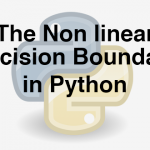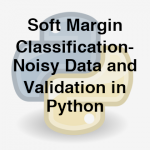
Link to the previous post : https://statinfer.com/204-6-5-the-non-linear-decision-boundary/
In this session we will practice non linear kernels of SVM in python.
Practice : Kernel – Non linear classifier
- Dataset : Software users/sw_user_profile.csv
- How many variables are there in software user profile data?
- Plot the active users against and check weather the relation between age and “Active” status is linear or non-linear.
- Build an SVM model(model-1), make sure that there is no kernel or the kernel is linear.
- For model-1, create the confusion matrix and find out the accuracy.
- Create a new variable. By using the polynomial kernel.
- Build an SVM model(model-2), with the new data mapped on to higher dimensions. Keep the default kernel as linear.
- For model-2, create the confusion matrix and find out the accuracy.
- Plot the SVM with results.
- With the original data re-cerate the model(model-3) and let python choose the default kernel function.
- What is the accuracy of model-3?
In [19]:
#Dataset : Software users/sw_user_profile.csv
sw_user_profile = pd.read_csv("datasets/Software users/sw_user_profile.csv")
In [20]:
#How many variables are there in software user profile data?
sw_user_profile.shape
Out[20]:
In [21]:
#Plot the active users against and check weather the relation between age and "Active" status is linear or non-linear
plt.scatter(sw_user_profile.Age,sw_user_profile.Id,color='blue')
Out[21]:
In [22]:
#Build an SVM model(model-1), make sure that there is no kernel or the kernel is linear
#Model Building
X= sw_user_profile[['Age']]
y= sw_user_profile[['Active']].values.ravel()
Linsvc = svm.SVC(kernel='linear', C=1).fit(X, y)
In [23]:
#Predicting values
predict3 = Linsvc.predict(X)
In [27]:
#For model-1, create the confusion matrix and find out the accuracy
#Confusion Matrix
from sklearn.metrics import confusion_matrix
conf_mat = confusion_matrix(sw_user_profile[['Active']],predict3)
conf_mat
Out[27]:
In [28]:
#Accuracy
Accuracy3 = Linsvc.score(X, y)
Accuracy3
Out[28]:
New variable derivation. Mapping to higher dimensions
In [29]:
#Standardizing the data to visualize the results clearly
sw_user_profile['age_nor']=(sw_user_profile.Age-numpy.mean(sw_user_profile.Age))/numpy.std(sw_user_profile.Age)
In [30]:
#Create a new variable. By using the polynomial kernel
#Creating the new variable
sw_user_profile['new']=(sw_user_profile.age_nor)*(sw_user_profile.age_nor)
In [31]:
#Build an SVM model(model-2), with the new data mapped on to higher dimensions. Keep the default kernel as linear
#Model Building with new variable
X= sw_user_profile[['Age']+['new']]
y= sw_user_profile[['Active']].values.ravel()
Linsvc = svm.SVC(kernel='linear', C=1).fit(X, y)
predict4 = Linsvc.predict(X)
In [32]:
#For model-2, create the confusion matrix and find out the accuracy
#Confusion Matrix
conf_mat = confusion_matrix(sw_user_profile[['Active']],predict4)
conf_mat
Out[32]:
In [33]:
#Accuracy
Accuracy4 = Linsvc.score(X, y)
Accuracy4
Out[33]:
In [34]:
#With the original data re-cerate the model(model-3) and let python choose the default kernel function.
########Model Building with radial kernel function
X= sw_user_profile[['Age']]
y= sw_user_profile[['Active']].values.ravel()
Linsvc = svm.SVC(kernel='rbf', C=1).fit(X, y)
predict5 = Linsvc.predict(X)
conf_mat = confusion_matrix(sw_user_profile[['Active']],predict5)
conf_mat
Out[34]:
In [35]:
#Accuracy model-3
Accuracy5 = Linsvc.score(X, y)
Accuracy5
Out[35]:




